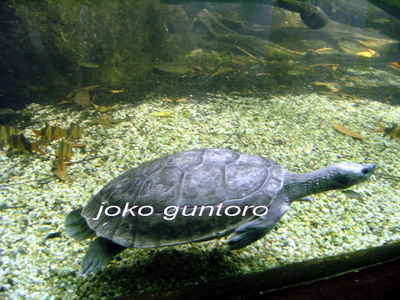How to care turtles

Keeping turtles require much attention, a long-term commitment, and their routine maintenance requires time set aside each day. With a proper habitat and clean environment, watching your turtle swim, dive and chase his food provides seemingly endless entertainment. Here are some tips for you to keep turtles:

Habitat
Keep the temperature at 77 to 95 degrees F for aquatic and semi aquatic species. Use an aquarium heater when needed; turtles and terrapins become sluggish and stop eating in low temperatures. A general rule of thumb is that your full-grown turtle’s body shouldn’t take up more than 25 percent of the floor space of the aquarium. Because aquatic turtles spend so much time in the water, the swimming area should be at least three-quarters of the tank and deep enough for the turtle to completely submerge in to swim in with ramps, rocks or bricks that allow him to easily get out of the water. The tank setup should provide a basking area for the turtle to dry off and soak up some heat. Basking is critical for drying and preventing shell problems. And since turtles can’t store vitamin D 3, they must be exposed to UVB light for absorption. Specialty ramps, a floating natural or artificial log, or even some large rocks can provide this.
Clean the entire aquarium (including the filtration system) at least once a month. Clean ponds or large enclosures where the animal spends time at least every three to six months. Prevent your turtle’s environment from becoming soiled by either netting or siphoning off all fecal matter as soon as possible. Fecal buildup can cause health problems.
Food
Watching your turtles diet. Whether your pet turtle is an herbivore, carnivore or omnivore. For example, red-eared sliders, painted turtles and other species are predominantly carnivorous during their youth and primarily omnivorous throughout their adulthood. While soft-shell turtles, on the other hand, are primarily carnivores. A complete turtle pellet provides a good base diet for aquatic pet turtles, but they all need daily additions. Herbivores speceis are often enjoy dark, leafy greens; while carnivores devour appropriately sized slugs, earthworms, guppies, brine shrimp and mealworms, and other live creatures. Omnivores need a selection of both types.
Supplement the diet with appropriate snacks: Earthworms, crustaceans, small fish, mouse pups, algae, leafy green vegetation and fruit are examples of suitable foods for terrapins. Semi aquatic species tend to be herbivorous – they tend to eat plants only. Feed your pet two to three times a week in a small holding tank that is separate from its normal enclosure; uneaten food can attract disease – causing microorganisms. Size of the food should be proportionate to the size of the turtle. Rinse off your turtle after a feeding with slightly warm water before returning him to his enclosure.

Water filtration
Keep the water clean to prevent health problems. Use an aquarium filtration system to maintain optimal water quality. Monitoring the temperature, salinity and pH of water. Some turtles prefer more salinity in their water; learn about your species to find the specific level and add the special sea salt available at aquarium stores to adjust the salinity. Perform water changes daily, if possible, or a few times a week. Bare-bottom tanks help keep the water clean, as does a quality filtration system.
Temperature
Temperature plays a vital role in your turtle’s health and happiness. Too cold or too warm could stress him out or make him ill. For most aquatic turtles, the water temperature should be between 75 and 80 degrees; soft-shelled turtles prefer slightly cooler temperatures in from 72 to 75 degrees. Keep an eye on the water temperature with a tank thermometer. Room temperature will be a little too chilly for his basking area; point a heat lamp over the basking ramps or rocks to make the air temperature in the mid-80s to low 90s.
